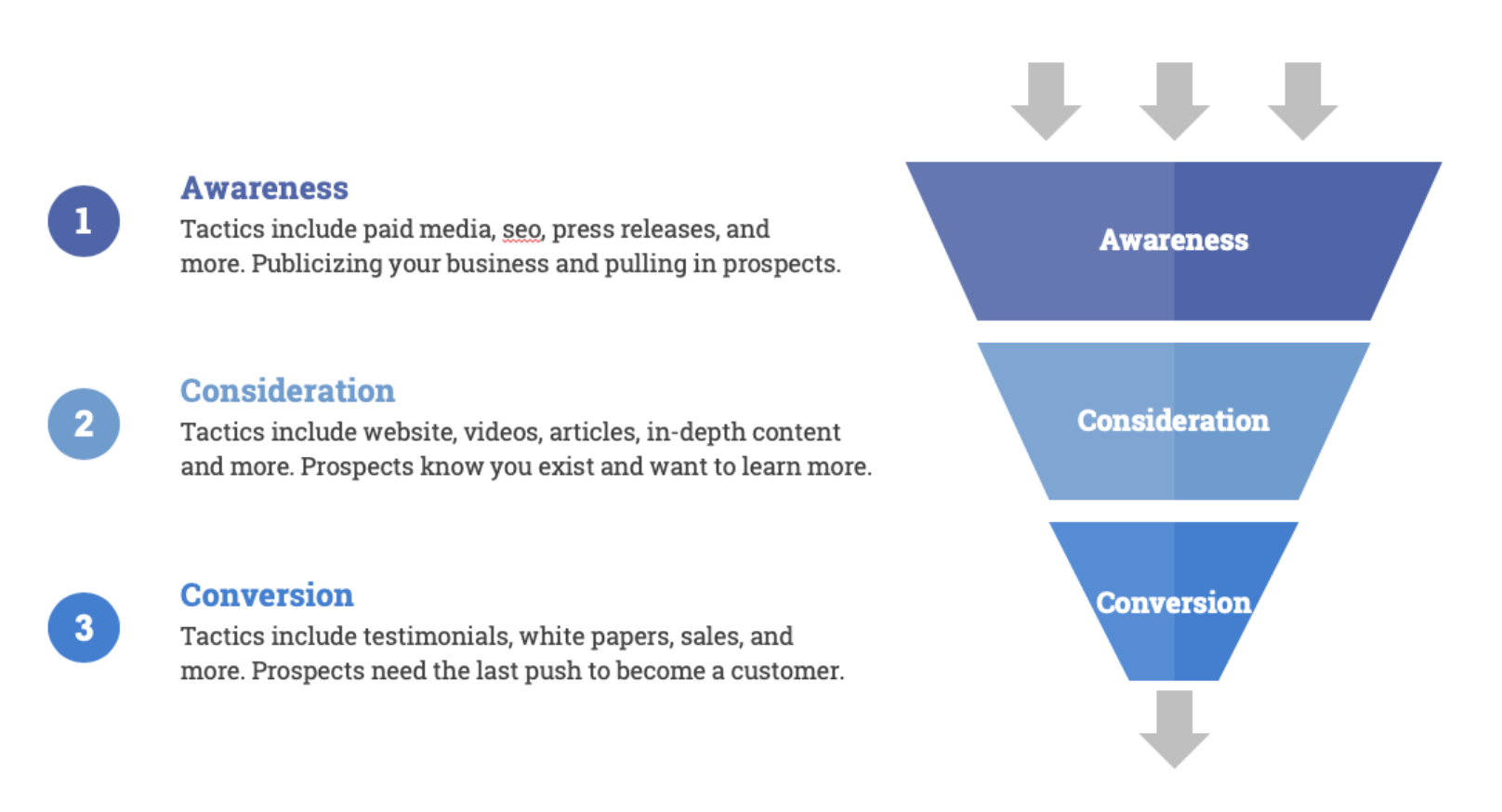Comparing content that works vs. content that doesn't
There are many factors that contribute to why a given piece of content does or doesn’t perform. Different types of content serve different purposes within the marketing funnel. For this examination, we will look at content that fits into the awareness phase of the marketing funnel. Click the image below for an introduction to the marketing funnel.
From an organic perspective, awareness content is generally more broad and serves a wide audience. For example, a piece of awareness content might be titled, “How To Sweep Your Floor.” Whereas, a piece of consideration content might be “The Top 5 Brooms of 2023.”
Let’s take a look at a few pieces of video content that we have produced in the awareness stage. Both pieces are more than 3 years old. They have had ample time to be able to draw audiences. Yet, one of the videos has over 183,000 views and the other has just 65 views. We will examine the 65 views video first.
Video #1 - The content that didn’t work
This video was shot for a health and lifestyle blog that is distributed by Intermountain Healthcare. Part of this blog features healthy food content. The blog post features the recipe as well as the video. For this comparison, we will focus on the pages that the videos are hosted on.
If we examine the video from a search perspective, we can see that the word recipe is not featured in the title. The video is titled Health 360: Veggie and Peach Stuffed Tomatoes. Someone searching for a search term like this would likely have a very specific end goal in mind. A title that might serve the awareness stage better might be, “Tomato Side Dish Recipe,” or “How to Make This Tomato and Peach Salad.” Furthermore, we can see that there is no description of the video. If we put ourselves into the position of a searcher who might need this type of content, there is no information provided that tells us that the content is going to solve our problem or search. We might be searching for healthy sides but there is nothing here that a search engine can pick up on that says that this is a recipe for a healthy side dish.
The video content itself is produced well, and it serves its purpose in providing the instructions for the recipe. But without the elements to increase its visibility in search, it is essentially rendered useless to gathering any sort of audience.
Video #2 - The content that worked
This video was shot for Arrow Electronics. It features a supplier of soldering irons discussing the care and cleaning procedures for soldering tips.
In this video, you will notice that the title is a broad search term and the content matches exactly what the searcher is hoping to solve. As a bonus, even though this is an awareness piece of content, it leads the viewer into the marketing funnel as it features the products that the searcher might consider to solve their problem. So they may begin in the awareness phase, but we have already led them into a consideration of the products featured.
You can also see that the brief description provides the viewer with a knowledge of what they are about to view, as well as some additional information and links. It is to the point and gives the viewers the necessary information to solve their problem/search.
This video also features chapters that enable the viewer to find the information they are seeking faster. This type of interactive element makes the content more engaging for the viewer.
Conclusions
With a few simple tweaks to the Tomato recipe video, and some repromoting on social channels, we could analyze if improving the SEO might result in greater engagement and traffic. Another consideration would be to experiment with some different channels for the video. Instagram, Pinterest, and TikTok tend to lend better results in the food space than Vimeo. Comparatively, YouTube serves “How To…” type content like the soldering tip cleaning video very well. It is always important to consider what types of content fit your channels best.
The truth is, creating content is inherently risky. There is no sure fire formula that will serve you to create content that is going to work every single time. There are other factors such as time, promotion, brand awareness, and more that will affect your individual results. You can take part in exercises like these to analyze areas of improvement. And then you can apply what you learn when you create your goals and plans for your own content. If we continually analyze and strive for improvement, we can create more content with 183,000 views, and less with under 100.



